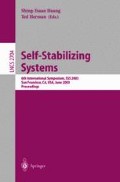Abstract
In this paper a self-stabilizing program for solving a pursuer-evader problem in sensor networks is presented. The program can be tuned for tracking speed or energy efficiency. In the program, sensor motes close to the evader dynamically maintain a “tracking” tree of depth R that is always rooted at the evader. The pursuer, on the other hand, searches the sensor network until it reaches the tracking tree, and then follows the tree to its root in order to catch the evader.
This work was partially sponsored by DARPA contract OSU-RF #F33615-01-C-1901, NSF grant NSF-CCR-9972368, an Ameritech Faculty Fellowship, and two grants from Microsoft Research.
Access this chapter
Tax calculation will be finalised at checkout
Purchases are for personal use only
Preview
Unable to display preview. Download preview PDF.
References
A. Arora and M. G. Gouda. Distributed reset. IEEE Transactions on Computers, 43(9):1026–1038, 1994. 12, 14
B. Awerbuch and D. Peleg. Sparse partitions (extended abstract). In IEEE Symposium on Foundations of Computer Science, pages 503–513, 1990. 15
B. Awerbuch and D. Peleg. Online tracking of mobile user. Journal of the Association for Computing Machinery, 42:1021–1058, 1995. 1, 15
A. Bar-Noy and I. Kessler. Tracking mobile users in wireless communication networks. In INFOCOM, pages 1232–1239, 1993. 1
A. Bar-Noy, I. Kessler, and M. Sidi. Mobile users: To update or not to update? In INFOCOM, pages 570–576, 1994. 15
G. Barnes and U. Feige. Short random walks on graphs. SIAM Journal on Discrete Mathematics, 9(1):19–28, 1996. 9
N. S. Chen and S. T. Huang. A self-stabilizing algorithm for constructing spanning trees. Information Processing Letters (IPL), 39:147–151, 1991. 12, 14
Y. Choi, M. Gouda, M. C. Kim, and A. Arora. The mote connectivity protocol. Technical Report TR03-08, Department of Computer Sciences, The University of Texas at Austin, 2003. 3
A. Cournier, A.K. Datta, F. Petit, and V. Villain. Self-stabilizing PIF algorithms in arbitrary networks. International Conference on Distributed Computing Systems (ICDCS), pages 91–98, 2001. 12, 14
D. Gay, P. Levis, R. von Behren, M. Welsh, E. Brewer, and D. Culler. The nesC language: A holistic approach to network embedded systems. Submitted to the ACM SIGPLAN(PLDI), June 2003. 14
M.P. Herlihy and S. Tirthapura. Self-Stabilizing Distributed Queuing. Proceedings of the 15th International Symposium on Distributed Computing, 2001. 14
J. Hill, R. Szewczyk, A. Woo, S. Hollar, D. Culler, and K. Pister. System architecture directions for network sensors. ASPLOS, 2000. 4, 14
S. Ikeda, I. Kubo, N. Okumoto, and M. Yamashita. Local topological information and cover time. Research manuscript, 2002. 9
M. Jayaram and G. Varghese. Crash failures can drive protocols to arbitrary states. ACM Symposium on Principles of Distributed Computing, 1996. 1
V. Mittal, M. Demirbas, and A. Arora. LOCI: Local clustering in large scale wireless networks. Technical Report OSU-CISRC-2/03-TR07, The Ohio State University, February 2003. 15
E. Pitoura and G. Samaras. Locating objects in mobile computing. Knowledge and Data Engineering, 13(4):571–592, 2001. 1
A.P. Sistla, O. Wolfson, S. Chamberlain, and S. Dao. Modeling and querying moving objects. In ICDE, pages 422–432, 1997. 1
Author information
Authors and Affiliations
Editor information
Editors and Affiliations
Rights and permissions
Copyright information
© 2003 Springer-Verlag Berlin Heidelberg
About this paper
Cite this paper
Demirbas, M., Arora, A., Gouda, M.G. (2003). A Pursuer-Evader Game for Sensor Networks. In: Huang, ST., Herman, T. (eds) Self-Stabilizing Systems. SSS 2003. Lecture Notes in Computer Science, vol 2704. Springer, Berlin, Heidelberg. https://doi.org/10.1007/3-540-45032-7_1
Download citation
DOI: https://doi.org/10.1007/3-540-45032-7_1
Published:
Publisher Name: Springer, Berlin, Heidelberg
Print ISBN: 978-3-540-40453-8
Online ISBN: 978-3-540-45032-0
eBook Packages: Springer Book Archive

